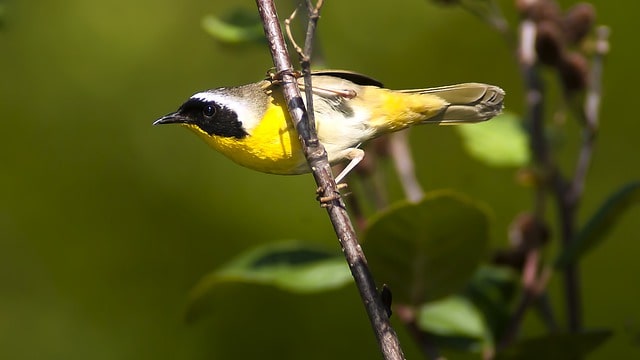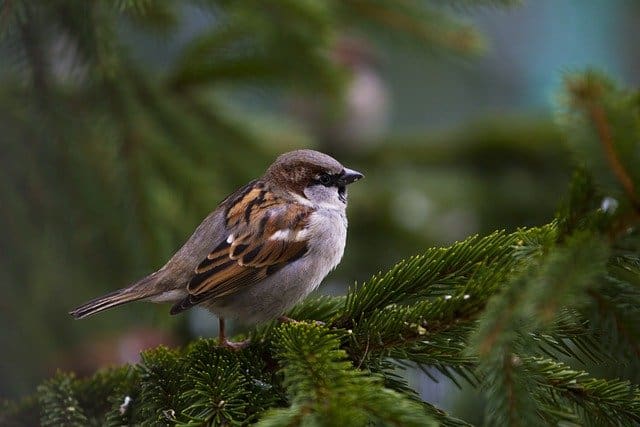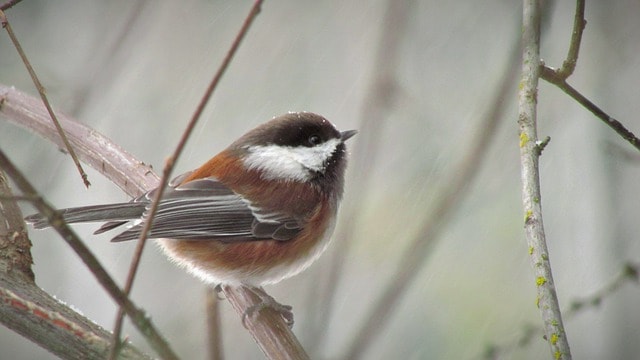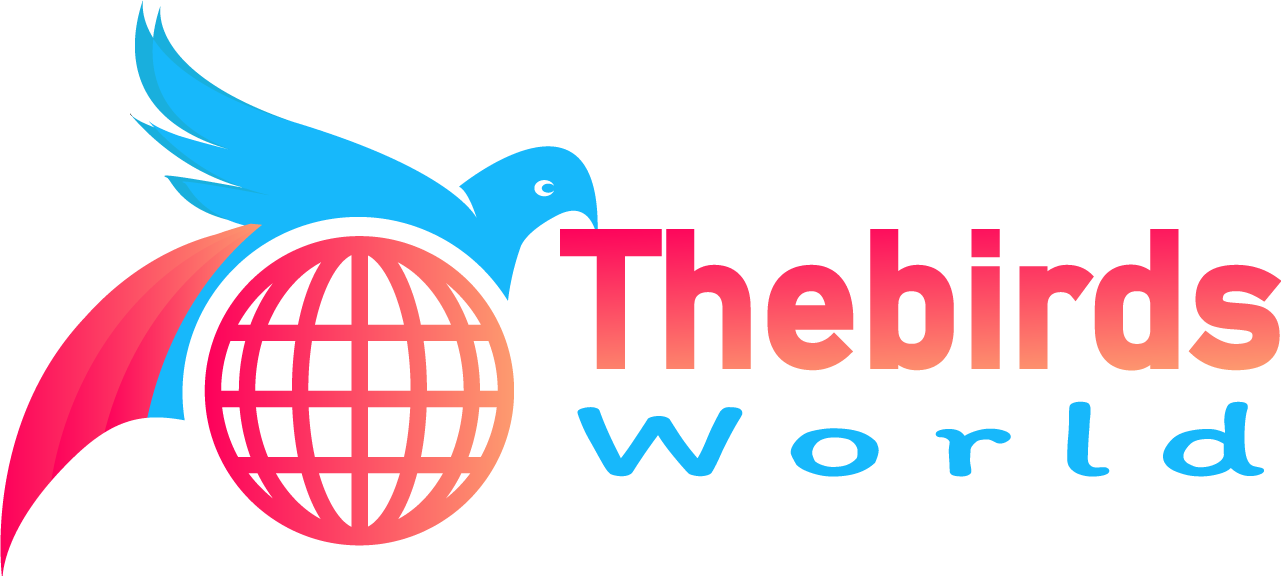16 Small Brown Birds
- Common Yellowthroat
- Song Sparrow
- Chipping Sparrow
- House Sparrow
- Golden-crowned Sparrow
- Carolina Wren
- White-throated Sparrow
- House Wren
- Great-crested Flycatcher
- Eastern Phoebe
- Pine Siskin
- Chestnut-backed Chickadee
- American Tree Sparrow
- Field Sparrow
- Brown-headed Cowbird
- Bewick’s Wren
Common Yellowthroat

Yellowthroats are little brown songbirds with long tails and bright yellow underbelly. The males wear black mask that covers their entire face. The intensity of the yellow in these birds varies according to region.
During the spring and summer, they may be found in marshy or wetland locations, as well as brushy fields, where they live in dense, tangled vegetation.
They consume largely insects and can be found in vast, densely vegetated backyards.
Song Sparrow

The song sparrow is a little bird that is only found in the Americas. It is without a doubt one of America’s most plentiful, diversified, and adaptable native bird species.
It’s incredible to consider that if this lovely bird decides to make our backyard it’s permanent home, we may be the first to see it.
Tree bark, rocks, logs, and even steep rocky outcrops are among their favorite habitats.
To attract more song sparrows to your backyard feeders, use black oil sunflower seeds, cracked corn, and nyjer on platform feeders.
Chipping Sparrow

Long, thin tails, a greyish belly, a brown and black-streaked back, a rusty cap, and a black eye-line characterize Chipping Sparrows. The colors are more subdued in the winter.
They reproduce over much of North America and Canada before migrating for the entire year to Mexico, Florida, or further south.
They are often seen in small groups on open ground and will visit backyards in search of various types of birdseed.
House Sparrow

Another successful immigrant that has become one of the most prevalent birds is the House Sparrow.
They’re prevalent around buildings and, because they’re gentle, they’ll eat straight out of your palm.
They are pests since they are non-native, yet if they are not fed, they will still be found in backyards.
Most bird seeds can attract more House Sparrows to your backyard feeders, including millet, maize, and sunflower seeds.
Golden-crowned Sparrow

Sparrows with golden crowns are grayish-brown on the underside and streaked brown on the back. Their heads feature a black crown and a brilliant yellow forehead.
These birds molt during winter and the overall hues are dull with brown on the crown and a dull yellow forehead.
Apples, grapes, elderberries, and olives are among the fruits they consume. Ants, beetles, butterflies, and termites are among the insects that they consume.
If you want to attract Golden-crowned Sparrows to your yard then feed them seeds in ground feeders or grow fruit-bearing native plants.
Carolina Wren

The Carolina Wren is a small bird that looks similar in size to an American Goldfinch or a House Finch.
They have a spherical body, a short neck, a flat head, and a flapping tail. Its top body is reddish-brown, with black bands on its wings and tail. A white brow line and a buff underbelly.
They are common in backyard feeders and can be found in forested or overgrown areas.
Use suet feeders, hulled sunflower seeds, or peanut hearts in giant tube feeders or on platform feeders to attract more Carolina Wrens to your backyard feeders.
White-throated Sparrow

White-throated Sparrows have shining white throats, and yellow between the eye and bill with black and white striped heads. Their backs are brown and their undersides are grey.
Large groups of White-throated Sparrows can be observed on the ground in forests and along the margins.
Grass and weed seeds, as well as fruits including grape, sumac, mountain ash, blueberry, blackberry, and dogwood, make up the White-throated Sparrow’s diet. During the summer, they will devour a significant amount of insects off the forest floor.
House Wren

Little brown birds with dark banded wings and tails and a whitish neck are known as House Wrens. Before wintering in the extreme south and Mexico, most states have breeding populations.
House Wrens can be aggressive when it comes to nesting sites, bullying larger birds and even dragging eggs and young away from a chosen position.
By leaving piles of brush for protection or creating a nest box to tempt a breeding pair, you can attract more House Wrens to your garden.
Great-Crested Flycatcher

The Great Crested Flycatcher is a species of cormorant. A flycatcher’s back is brown, with a yellow abdomen and a grey neck. Crimson flashes can be seen on the wing and tail feathers. The crest isn’t really noticeable.
They sit in the trees, waiting for massive insects like butterflies, grasshoppers, moths, wasps, and spiders to fly by.
They can be found perched on fenceposts and other man-made structures in mixed woodlands, clearings, parks, and tree-lined neighborhoods. They’ll also consume berries and small fruit.
To attract more Great Crested Flycatchers, grow native plants and keep brush piles in your garden to attract insects.
Eastern Phoebe

Eastern Phoebes are large songbirds with a grayish-brown back, pale underbelly, and a darker crown.
Eastern Phoebes are usually encountered alone in peaceful woods, waving their tails from low perches, rather than in couples or flocks.
They build their nests from mud and grass on bridges, barns, and homes. Install a nest box or native plants that yield berries to attract additional Eastern Phoebes to your yard.
Pine Siskin

Pine Siskins are little birds with brown and yellow stripes on their wings and tails. They feature a forked tail and pointed wings, as well as a short pointed beak.
Pine Siskins eat conifer seeds, as well as juvenile buds and seeds from grasses and weeds, as their name suggests.
Pine Siskins are attracted to thistle and nyjer feeders, as well as black oil sunflower seeds and suet.
Chestnut-backed Chickadee

Chestnut-backed Chickadees are little birds with black and white heads, rich chestnut brown backs, grey wings, and grey bellies.
Caterpillars, spiders, wasps, and aphids make up the majority of their food, with seeds, berries, and fruit accounting for the remainder.
Black-oil sunflower seeds, suet, nyjer, peanuts, or mealworms in tube feeders, platform feeders, or suet cages can all be used to attract Chestnut-backed Chickadees to your yard.
American Tree Sparrow

American Tree sparrows are long-tailed brown-streaked plump birds with rusty caps, grey faces, and rusty eyeliner. They usually graze in tiny swarms in weedy fields and under bird feeders.
Black oil sunflower seeds, nyjer, cracked corn, and millet may all be used to attract more American Tree Sparrows to your backyard platform feeders.
They also forage for seeds fallen or abandoned from above on the ground under tube feeders.
Field Sparrow

Field Sparrows are little brown-backed birds with black streaks on their backs. Their heads, as well as their undersides, are grey, and they have a crimson crown and pink beak.
They eat weeds and seeds silently and are frequently overlooked since they favor abandoned areas and are timid.
Males sing from a perch in the early mornings during the mating season, making them easier to locate.
Brown-headed Cowbird

Brown-headed Cowbird males have huge heads, brown heads, black bodies, and short tails. Females have a dusting of stripes on their backs and are brown in colour.
They are considered a nuisance because they eat the eggs of smaller songbirds in order to lay their own eggs in the nest and have the bird care for their young.
They spawn throughout most of northern and western North America before migrating south, although they spend the full year in the Eastern and Southern states, as well as along the Pacific Coast.
They may be found on grassland and woodland borders, pastures, and backyards, where they graze mostly on grass and weed seeds.
Bewick’s Wren

Brown-backed birds with long erect tails are Bewick’s Wrens. Their bellies are grey, and they have a white stripe across their eyes.
They may be found jumping from branch to branch, flicking their long tails, in the scrub, thickets, and open forest.
They eat insects and larvae, suet, mealworms, and hulled sunflower seeds that may be found in backyard feeders.
Related Articles You May Like


